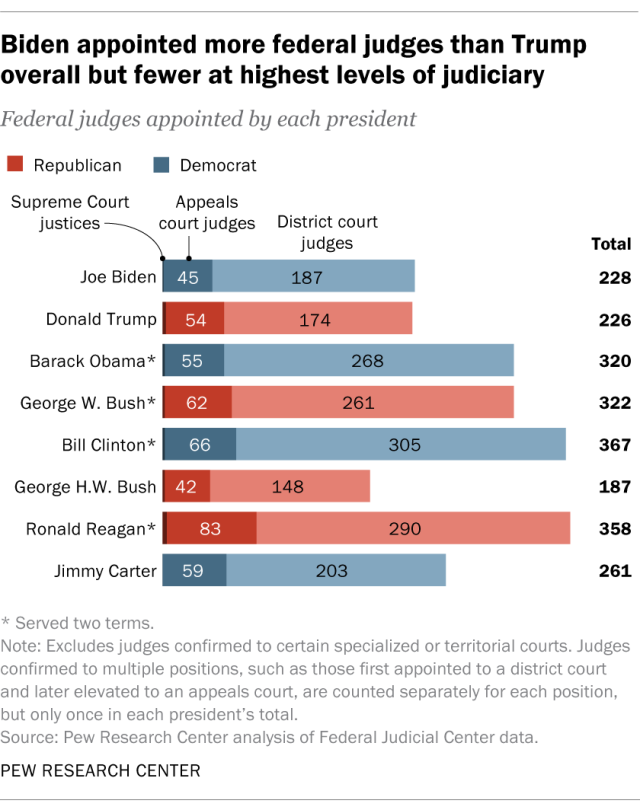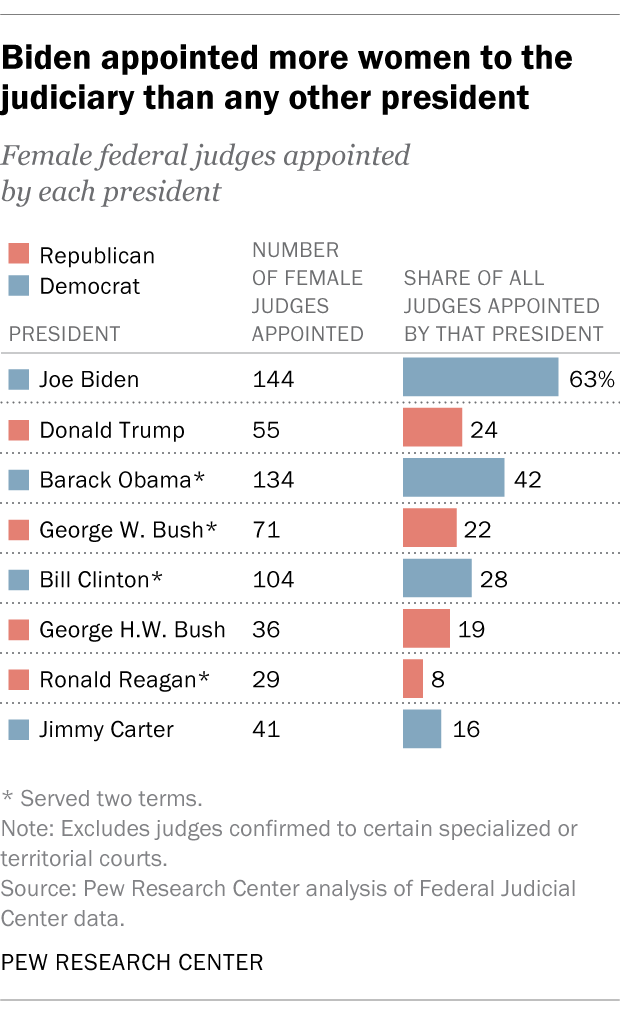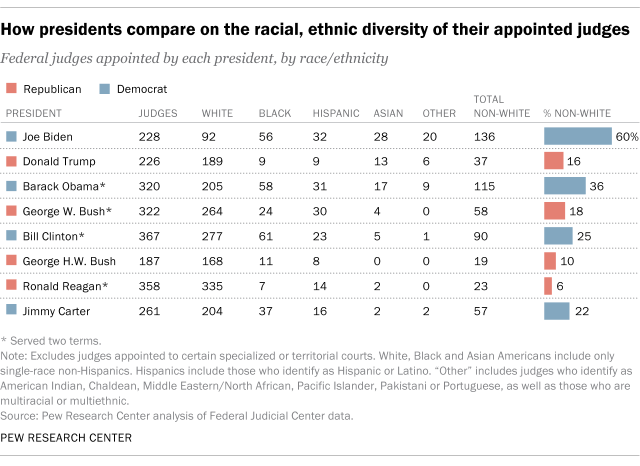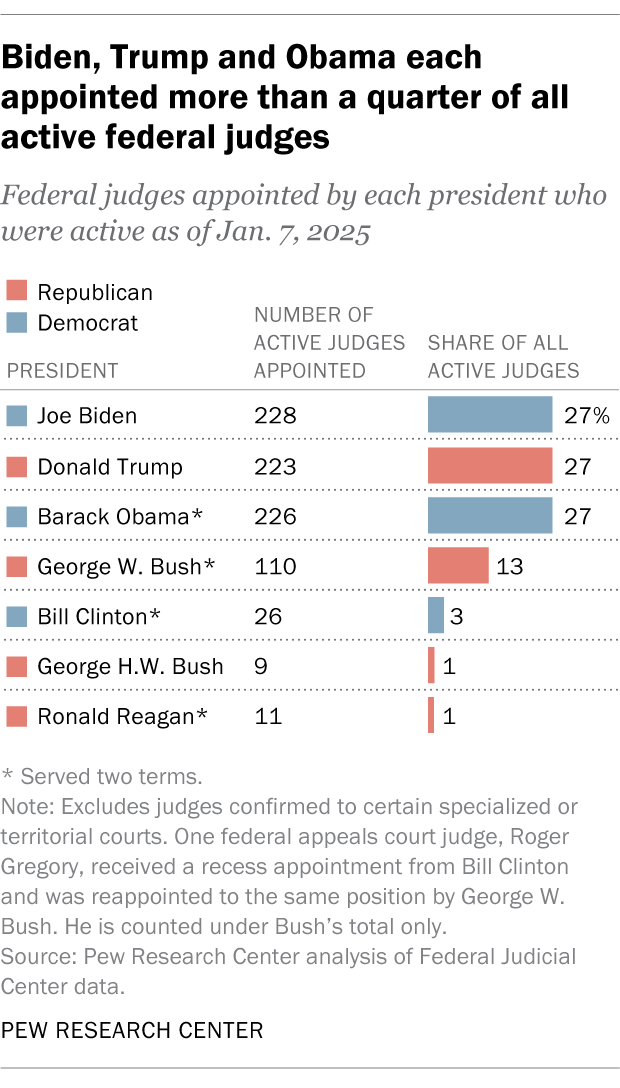How Biden compares with other recent presidents in appointing federal judges (original) (raw)
Following a flurry of judicial confirmations in the final weeks of the 118th Congress, President Joe Biden will end his tenure in the White House having appointed 228 judges to the federal courts. That figure includes record numbers of women and racial or ethnic minorities.
Biden’s total narrowly eclipses the 226 federal judges Donald Trump appointed during his first term as president. Trump, however, will soon be able to add to his tally as he prepares to take office for a second term, which will start with a Republican Senate majority.
As Biden’s term draws to a close, here’s a look at the federal judges the 46th president appointed during his four years in the White House. This analysis is based on data from the Federal Judicial Center, the research and education arm of the federal judiciary.
This analysis focuses only on judges appointed to the 91 district courts and 13 appeals courts governed by Article III of the U.S. Constitution, as well as the U.S. Supreme Court. It excludes judges appointed to certain specialized courts, such as the U.S. Court of International Trade, and appointees to non-Article III territorial courts in Guam, the Northern Mariana Islands and the U.S. Virgin Islands. For additional methodological information, click on the “How we did this” box below.
Federal judicial appointments are an important part of a president’s legacy. As Joe Biden prepares to leave the White House, we analyzed how his record on judicial appointments compares with that of other recent presidents, going back to Jimmy Carter. The analysis is based on data published by the Federal Judicial Center, the research and education agency of the federal judicial branch.
Our analysis focuses only on judges serving in the three main tiers of the federal court system: the 91 district courts and 13 appeals courts governed by Article III of the U.S. Constitution, as well as the U.S. Supreme Court. It excludes judges appointed to certain specialized courts, such as the U.S. Court of International Trade, and appointees to non-Article III territorial courts in Guam, the Northern Mariana Islands and the U.S. Virgin Islands.
This analysis counts judges once under each president’s total, even if they were appointed to multiple positions. For example, Biden appointed Ketanji Brown Jackson to an appeals court in 2021 before elevating her to the Supreme Court a year later. Biden’s total counts Jackson only once.
White, Black and Asian judges include only those who identify as single-race non-Hispanic, as reported by the Federal Judicial Center. Hispanic judges include those who identify as either Hispanic or Latino. “Other” judges include those who identify as American Indian, Chaldean, Middle Eastern/North African, Pacific Islander, Pakistani or Portuguese, as well as those who are multiracial or multiethnic.
Active federal judges in this analysis exclude those who are on senior status. As of Jan. 7, 2025, there were 833 active judges, while another 624 were on senior status – a form of semiretirement that judges can take if they meet certain criteria.
Compared with Trump, Biden appointed more district court judges but fewer appeals court judges and U.S. Supreme Court justices. Biden appointed 187 judges to the federal district courts, which handle criminal and civil trials, and 45 judges to the federal appeals courts, which handle appeals of cases decided in district courts. He also appointed one justice, Ketanji Brown Jackson, to the Supreme Court, which has the final word on federal legal appeals. (This analysis counts judges once in each president’s total, even if they were appointed to multiple positions. For example, Biden first appointed Jackson to an appeals court in 2021 before elevating her to the Supreme Court in 2022.)
Trump appointed fewer district court judges than Biden (174 vs. 187) but more appeals court judges (54 vs. 45). He also appointed three Supreme Court justices in his first term in office: Neil Gorsuch, Brett Kavanaugh and Amy Coney Barrett. Trump’s trio of high court justices were the most of any president since Ronald Reagan, who appointed four.
Biden appointed more women to the federal judiciary than any other president – including presidents who served twice as long. Biden named 144 women judges, amounting to 63% of his total appointments to the courts. Both in absolute number and as a share of his total, Biden appointed more women to the judiciary than any other president. Barack Obama previously held this record, appointing 134 women judges – or 42% of his total – over eight years in office.
Democratic presidents have long been more likely than Republican presidents to appoint women judges. In fact, Democrats appointed 70% of all women who have ever served as federal judges.
But appointing women has become more common in both parties over time. For example, while women accounted for just 8% of Reagan’s judicial appointees, they made up a growing share of each subsequent Republican president’s appointees (19% for George H.W. Bush, 22% for George W. Bush and 24% for Trump).
No president appointed a more racially and ethnically diverse slate of judges than Biden. A 60% majority of the judges appointed by Biden – 136 out of 228 – are Black, Hispanic, Asian or part of another racial or ethnic minority group. That represents both the highest number and share of any president. During Obama’s two terms in office, he appointed 115 judges who were racial or ethnic minorities, amounting to 36% of his total. Bill Clinton appointed 90 minority judges during his two terms, representing a quarter of his total judicial appointees.
Biden especially stands out in appointing minority women to the federal judiciary. He appointed more Black women (35), Hispanic women (19) and Asian women (17) than any other president. All told, 37% of the judges appointed by Biden – 85 out of 228 – are women of a race or ethnicity other than White alone. By comparison, just 5% of Trump’s first-term judicial appointees were women of a race or ethnicity other than White alone.
Biden appointees now account for more than a quarter of all active federal judges. As of Jan. 7, there were 833 active judges serving in the three main tiers of the federal court system: the 91 district courts and 13 appeals courts governed by Article III of the U.S. Constitution, as well as the U.S. Supreme Court. Biden appointed 27% of those judges (228).
The number of active federal judges changes regularly because of retirements, resignations, new appointments and other reasons. But as of Jan. 7, Biden’s appointees represented:
- 28% of the nation’s active district court judges
- 25% of active appeals court judges
- 11% of sitting Supreme Court justices (one of nine)
Overall, Democratic presidents appointed 60% of all active judges at the district court level, while Republican chief executives appointed the remaining 40%. The appeals courts are nearly evenly divided between appointees of Democratic and Republican presidents (49% vs. 51%), while the Supreme Court has twice as many appointees of GOP as Democratic presidents (six vs. three).
Note: This is an update of a post originally published on Aug. 9, 2022.



